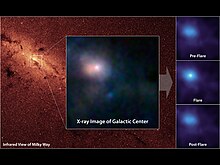
Back برنامج إكسبلوررز Arabic Експлорър (програма) Bulgarian Programa Explorer Catalan Program Explorer Czech Explorerprogrammet Danish Explorer-Programm German Πρόγραμμα Explorer Greek Programa Explorers Spanish برنامه کاوشگران Persian Programme Explorer French

The Explorers program[1] is a NASA exploration program that provides flight opportunities for physics, geophysics, heliophysics, and astrophysics investigations from space. Launched in 1958, Explorer 1 was the first spacecraft of the United States to achieve orbit. Over 90 space missions have been launched since. Starting with Explorer 6, it has been operated by NASA, with regular collaboration with a variety of other institutions, including many international partners.
Launchers for the Explorer program have included Juno I, Juno II, various Thor, Scout, Delta and Pegasus launch vehicles, and Falcon 9.
The program has three classes: Medium-Class Explorers (MIDEX), Small Explorers (SMEX), and University-Class Explorers (UNEX), with select Missions of Opportunity operated with other agencies.
- ^ "Explorers Program". Explorers Program Home Page at NASA Goddard. NASA. Retrieved 3 May 2022.
© MMXXIII Rich X Search. We shall prevail. All rights reserved. Rich X Search